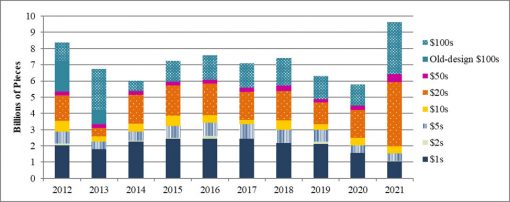
The pace of U.S. currency production will quicken in 2021, possibly to the highest level in at least 15 years, according to a Federal Reserve order submitted to the Bureau of Engraving and Printing (BEP).
Unlike in past years, the order submitted includes ranges of notes by denomination instead of specific amounts, with the overall production total for FY 2021 placed between 7.5 and 9.6 billion notes. This change from the past is attributed to COVID-19.
"To better address possible shifts in note demand and note production due to the pandemic, the FY 2021 print order is … a range by denomination. During FY 2021, Board and BEP staff will adjust production of each denomination within these ranges to best match available production with demand throughout the year," the currency print order stated.
The figures come from a print order approved and submitted by the Board of Governors of the Federal Reserve, the issuing authority for U.S. banknotes. It reflects the board’s estimate of net demand for currency in FY 2021 from both domestic and international customers.
In April, the Board revised its FY 2020 order from 5.2 billion to 6.2 billion notes to meet increased demand for currency because of the pandemic. The order was revised again in August to 5.8 billion notes with an improved blend of denominations after collaborating with the BEP.
Unchanged from past years, the latest order shows most of the banknotes produced will be $1s, $20s and $100s. It also includes $2 notes for the first time since 2019.
Traditionally, most notes are produced to replace those taken out of circulation because their condition no longer meets the criteria for recirculation or because they are of older designs. There is a change here as well.
"Unlike in past years when the major driver of the print order was replacement of unfit notes shredded at Reserve Banks, an increase in net payments drives the FY 2021 print order," the Feb Board said in its latest order statement
A note replacement estimate was not offered in either the 2021 or 2020 order. Replacement estimates totaled 90% in FY2019; 75% in FY 2018; 71% in FY 2017; and 70% in FY 2016.
For a bit more perspective regarding the expected uptick in demand for currency during Fiscal Year 2021, the latest order totals represent increases of 30.5% to 65.7% from the revised order placed for 2020 and increases of 7.4% to 36.4% from 2019; 2.2% to 29.8% from 2018; 6.5% to 35.3% from 2017; and -0.2% to 26.8% from 2016.
Cost of Making Federal Reserve Notes
The BEP’s cost of making money varies by banknote. For example, government figures for 2019 show production costs per note at:
- 5.5 cents for $1s and $2s — up from 5.5 cents in 2019.
- 15.5 cents for $5s — up from 11.4 cents in 2019.
- 15.9 cents for $10s — up from 11.1 cents in 2019.
- 16. 1 cents for $20s and $50s — up from 11.5 cents in 2019.
- 19.6 cents for $100s — up from 14.2 cents in 2019.
Late in 2019, the Fed approved a currency operating budget of $877.2 million for calendar year 2020, up $38.9 million, or 4.6%, from 2019 forecasted expenses of $838.3 million and includes $827.7 million of BEP costs and $49.5 million of Board costs
Banknote Orders by Denomination
The following table shows how the Fed’s latest order breaks down by denomination, number of notes and dollar value:
FY 2021 Federal Reserve Note Print Order
| Denomination | Number of Notes (000s of pieces) |
Dollar Value (000s of dollars) |
|---|---|---|
| $1 | 709,120 to 1,030,400 | $709,120 to $1,030,400 |
| $2 | 38,400 to 51,200 | $76,800 to $102,400 |
| $5 | 419,200 to 467,200 | $2,096,000 to $2,336,000 |
| $10 | 300,800 to 428,800 | $3,008,000 to $4,288,000 |
| $20 | 3,107,200 to 3,968,000 | $62,144,000 to $79,360,000 |
| $50 | 483,200 to 499,200 | $24,160,000 to $24,960,000 |
| $100 | 2,482,176 to 3,196,800 | $248,217,600 to $319,680,000 |
| Total | 7,568,896 to 9,612,800 | $341,237,120 to $430,931,200 |
The BEP operates on a fiscal year that begins on Oct. 1 and ends on Sept. 30. They agency produces all U.S. banknotes, and the order for 2021 includes currency set aside for numismatic products.
For reference, this table shows the banknote order totals placed for fiscal year 2020:
FY 2020 Federal Reserve Note Print Order
| Denomination | Number of Notes (000s of pieces) |
Dollar Value (000s of dollars) |
|---|---|---|
| $1 | 1,574,400 | $1,574,400 |
| $2 | 0 | $0 |
| $5 | 736,000 | $3,680,000 |
| $10 | 460,800 | $4,608,000 |
| $20 | 1,241,600 | $24,832,000 |
| $50 | 76,800 | $3,840,000 |
| $100 | 1,078,400 | $107,840,000 |
| Total | 5,168,000 | $146,374,400 |
Lastly, this Fed chart shows orders from FY 2012 to FY 2021:
The Bureau of Engraving and Printing produces banknotes at facilities in Fort Worth, TX and Washington, D.C. According to government data, there was approximately $1.99 trillion in circulation as of Oct. 7, 2020.






